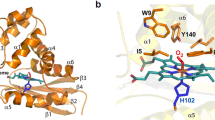Abstract.
Several classes of heme proteins have been identified whose primary role is to sense and transport one of the three gaseous ligands: O2, NO, or CO. A common feature shared by all of these proteins is the need to not only recognize its target ligand, but also discriminate against other heme ligands of similar size and shape. This review describes the mechanisms that each class of heme protein sensor and transporter utilizes to promote this discrimination. The common factors utilized in the recognition of each ligand are discussed.
Similar content being viewed by others
Author information
Authors and Affiliations
Additional information
Electronic Publication
Rights and permissions
About this article
Cite this article
Jain, R., Chan, M.K. Mechanisms of ligand discrimination by heme proteins. J Biol Inorg Chem 8, 1–11 (2003). https://doi.org/10.1007/s00775-002-0405-8
Received:
Accepted:
Issue Date:
DOI: https://doi.org/10.1007/s00775-002-0405-8




